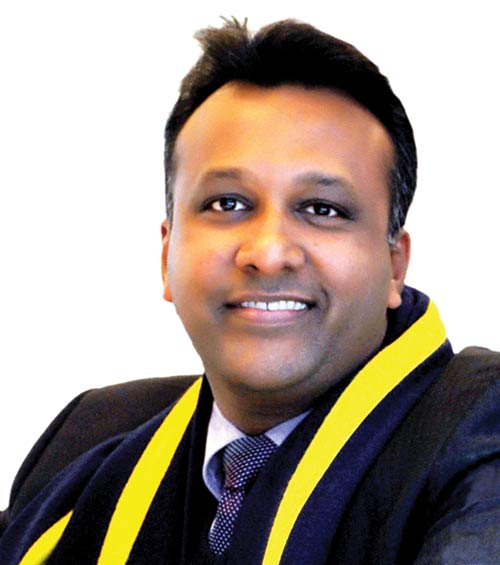 India’s aspirations to build world-class universities that promote excellence in teaching, research and knowledge creation are as overdue as they are laudable. The early history of higher education institutions in India and the contribution of Indian civilisational heritage to the world is truly remarkable.
India’s aspirations to build world-class universities that promote excellence in teaching, research and knowledge creation are as overdue as they are laudable. The early history of higher education institutions in India and the contribution of Indian civilisational heritage to the world is truly remarkable.
Against this backdrop, there is palpable disappointment that contemporary India doesn’t host any world-class universities in the forefront of research and institution development. While there’s been a steady decline in the quality and academic standards of most higher education institutions in India, Asia has witnessed a dramatic rise in the number of universities fostering teaching and research excellence. Some of the leading universities of China, Hong Kong, Taiwan, South Korea and Japan are at the forefront of promoting academic excellence in Asia. Indian universities need to draw inspiration from the top-ranked higher education institutions of Asia which have succeeded in dramatically upgrading their universities in a relatively short span of time.
There are several challenges that need to be addressed, if we are to move towards building a world-class higher education system, without which this country cannot attain first world status.
Regulation and governance. India’s higher education system is over-regulated and under-governed. This is evident in recent government policies designed to reduce regulatory oversight through initiatives such as graded autonomy for well-performing institutions, and the Institutions of Eminence project that allows selected institutions to self-regulate critical functions such as recruitment, admission and collaborations.
However given huge gaps in scale, access and relative quality of higher education across the country, further reforms to keep pace with the rapid expansion of the education sector are urgently needed. We also need greater engagement from the private sector, including industry, to promote quality in higher education. If one were to examine the parameters on which international ranking agencies such as THE (Times Higher Education), QS (Quacquarelli Symonds) and the Shanghai Jiao Tong ARWU (Academic Ranking of World Universities) assess universities, common metrics such as research, reputation and internationalisation are prominent. Yet Indian universities are insular and primarily focused on teaching.
The functions of internationalisation (i.e, hiring international faculty, admitting international students and building student mobility programmes) within higher education institutions are over-regulated by government. For the higher education system to flourish and prosper, greater balance between government oversight, institutional autonomy and a diversified funding ecosystem within the country is necessary.
Research and funding. Indian universities need to prioritise research impact and outcomes. This requires larger fund flows which ought to come from public and private sources. Moreover, regulations that encumber the internationalisation efforts of universities need to be eased and institutions of higher education need to be encouraged to promote all forms of internationalisation.
We need to build an ecosystem in which students all over the world should want to study in India just as we have created student mobility programmes under which Indian students go abroad for short and long-term programmes. All this requires substantially greater financial support from government, private industry and philanthropists. While public universities commendably provide broadest access to students from socio-economically underprivileged and disadvantaged communities, private higher education institutions need to also play a far greater role in expanding access to quality higher education in India.
Regrettably, the higher education sector is yet to experience sufficient establishment of not-for-profit universities funded by corporates and high net worth individuals who support access to quality higher education. O.P. Jindal Global University is a stellar example of private, not-for-profit and corporate philanthropy in higher education. Unfortunately for a large country like India there are few such examples and we need more of them.
The way forward. Contemporary nation states reflect the quality of their human resource and institutions. Visionaries who inspire others to change the status quo and build great education institutions are critical for national progress. For our citizens to dream, aspire and inspire, greater imagination and effort are required to create enabling and inspiring environments in the form of university spaces where teaching, learning and research happens. Institution-building is the precondition to nation-building and creating enabling environments for the future.
An alumna of Madras, Delhi, Oxford, Harvard and Hong Kong universities, Dr. C. Raj Kumar is the founding vice chancellor of O.P. Jindal Global University, Sonipat, Haryana (estb. 2009)

Building world-class universities
Against this backdrop, there is palpable disappointment that contemporary India doesn’t host any world-class universities in the forefront of research and institution development. While there’s been a steady decline in the quality and academic standards of most higher education institutions in India, Asia has witnessed a dramatic rise in the number of universities fostering teaching and research excellence. Some of the leading universities of China, Hong Kong, Taiwan, South Korea and Japan are at the forefront of promoting academic excellence in Asia. Indian universities need to draw inspiration from the top-ranked higher education institutions of Asia which have succeeded in dramatically upgrading their universities in a relatively short span of time.
There are several challenges that need to be addressed, if we are to move towards building a world-class higher education system, without which this country cannot attain first world status.
Regulation and governance. India’s higher education system is over-regulated and under-governed. This is evident in recent government policies designed to reduce regulatory oversight through initiatives such as graded autonomy for well-performing institutions, and the Institutions of Eminence project that allows selected institutions to self-regulate critical functions such as recruitment, admission and collaborations.
However given huge gaps in scale, access and relative quality of higher education across the country, further reforms to keep pace with the rapid expansion of the education sector are urgently needed. We also need greater engagement from the private sector, including industry, to promote quality in higher education. If one were to examine the parameters on which international ranking agencies such as THE (Times Higher Education), QS (Quacquarelli Symonds) and the Shanghai Jiao Tong ARWU (Academic Ranking of World Universities) assess universities, common metrics such as research, reputation and internationalisation are prominent. Yet Indian universities are insular and primarily focused on teaching.
The functions of internationalisation (i.e, hiring international faculty, admitting international students and building student mobility programmes) within higher education institutions are over-regulated by government. For the higher education system to flourish and prosper, greater balance between government oversight, institutional autonomy and a diversified funding ecosystem within the country is necessary.
Research and funding. Indian universities need to prioritise research impact and outcomes. This requires larger fund flows which ought to come from public and private sources. Moreover, regulations that encumber the internationalisation efforts of universities need to be eased and institutions of higher education need to be encouraged to promote all forms of internationalisation.
We need to build an ecosystem in which students all over the world should want to study in India just as we have created student mobility programmes under which Indian students go abroad for short and long-term programmes. All this requires substantially greater financial support from government, private industry and philanthropists. While public universities commendably provide broadest access to students from socio-economically underprivileged and disadvantaged communities, private higher education institutions need to also play a far greater role in expanding access to quality higher education in India.
Regrettably, the higher education sector is yet to experience sufficient establishment of not-for-profit universities funded by corporates and high net worth individuals who support access to quality higher education. O.P. Jindal Global University is a stellar example of private, not-for-profit and corporate philanthropy in higher education. Unfortunately for a large country like India there are few such examples and we need more of them.
The way forward. Contemporary nation states reflect the quality of their human resource and institutions. Visionaries who inspire others to change the status quo and build great education institutions are critical for national progress. For our citizens to dream, aspire and inspire, greater imagination and effort are required to create enabling and inspiring environments in the form of university spaces where teaching, learning and research happens. Institution-building is the precondition to nation-building and creating enabling environments for the future.
An alumna of Madras, Delhi, Oxford, Harvard and Hong Kong universities, Dr. C. Raj Kumar is the founding vice chancellor of O.P. Jindal Global University, Sonipat, Haryana (estb. 2009)